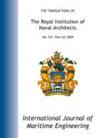CFD PREDICTION OF THE TRAJECTORY OF HOT EXHAUST FROM THE FUNNEL OF A NAVAL SHIP IN THE PRESENCE OF SHIP SUPERSTRUCTURE
IF 0.6
4区 工程技术
Q4 ENGINEERING, MARINE
引用次数: 1
Abstract
The superstructure of a modern naval ship is fitted with multitude of sensors for electronic surveillance, weapon discharge, navigation, communication and varieties of deck handling equipment. Locating these electronic equipment/sensors and its integration on board is of paramount importance to achieve optimal operational performance of the naval vessel. Among the many problems in locating these sensors (like stability, EMC EMI etc.,), the presence of entrapped hot gases from the ship exhaust affects the functioning of these electronics. Hence the prediction of temperature profile and trajectories of the ship exhaust plume from the funnel around the superstructure during the design stage is a mandatory requirement for positioning the sensors on superstructure. This trajectory prediction is not amenable to theoretical analysis or empirical calculation procedures in the modern warship superstructure. Experimental and CFD studies conducted on ship superstructure are the only reliable tools that are available to estimate temperature field as well as to study the exhaust smoke superstructure interaction on ships. This paper presents the CFD simulation of the published results for two cases, namely hot jet in a cross flow and hot exhaust with a cross flow on a generic frigate. Simulations have been made using k-ɛ turbulence model with different values of turbulent Schmidt number. It has been observed that temperature field is predicted with reasonable accuracy with turbulent Schmidt number of 0.2.舰船上层建筑存在时舰艇烟囱热排气轨迹的CFD预测
现代海军舰艇的上层建筑配备大量传感器用于电子监视、武器发射、导航、通信和各种甲板操作设备。定位这些电子设备/传感器及其在舰上的集成对于实现海军舰艇的最佳作战性能至关重要。在定位这些传感器的许多问题中(如稳定性、EMC、EMI等),船舶废气中被困的热气体的存在影响了这些电子设备的功能。因此,在设计阶段预测上层建筑周围漏斗的船舶排气羽流的温度分布和轨迹是上层建筑传感器定位的强制性要求。在现代军舰上层建筑中,这种弹道预测不适合理论分析或经验计算程序。对船舶上部建筑进行的实验和CFD研究是目前估计船舶温度场和研究船舶上部建筑排烟相互作用的唯一可靠工具。本文对某型护卫舰上横流热射流和横流热排气两种已发表的结果进行了CFD模拟。采用不同湍流施密特数的k- ε湍流模型进行了数值模拟。结果表明,当湍流施密特数为0.2时,对温度场的预测精度较高。
本文章由计算机程序翻译,如有差异,请以英文原文为准。
求助全文
约1分钟内获得全文
求助全文
来源期刊

International Journal of Maritime Engineering
ENGINEERING, MARINE-
CiteScore
1.20
自引率
0.00%
发文量
18
审稿时长
>12 weeks
期刊介绍:
The International Journal of Maritime Engineering (IJME) provides a forum for the reporting and discussion on technical and scientific issues associated with the design and construction of commercial marine vessels . Contributions in the form of papers and notes, together with discussion on published papers are welcomed.
 求助内容:
求助内容: 应助结果提醒方式:
应助结果提醒方式:


